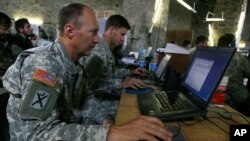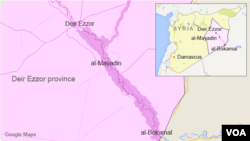Three days after a U.S. airstrike hit a group of people who Russia and Syria say were Syrian troops, there is still little clarity on who they were, and why Russia did not warn the United States that there were Syrian soldiers in the target area.
U.S. officials have said that they notified their Russian counterparts before carrying out airstrikes in Deir Ezzor Saturday, which the Russian Defense Ministry says killed 62 Syrian troops.
After the attack got under way, a Russian officer called the coalition's air operations center; however, the U.S. official assigned to handle calls from the Russians was not near the phone, and someone else took the call.
Col. John Thomas, the spokesman for U.S. Central Command, which oversees U.S. military operations in the Middle East, said that this first phone conversation was “cryptic."
“We weren’t exactly sure what they were saying,” he said.
He told VOA in an interview later that the coalition took a “good while” before the appropriate U.S. official and his or her Russian source made contact via a second call.
"I’m not sure how long the delay was or why,” Thomas told VOA, “but it wasn’t immediate.”
During that call, it became clear that the Russians believed coalition aircraft were hitting Syrian government forces, and the airstrikes were called off in less than five minutes.
From start to stop, the coalition strikes in Deir Ezzor Saturday lasted a little less than an hour, Thomas told reporters Tuesday.
The U.S. and Australia, whose planes also took part in the strike, have expressed deep regret for any unintentional loss of life of Syrian forces.
Thomas said that while Saturday’s airstrike was a dynamic strike, or one that requires more immediate responsiveness, it was not rushed.
“For roughly two full days we were observing this target and believed that we had pretty good intelligence on what we were looking at,” he said.
Syrian soldiers or prisoners?
The latest news on the U.S.-Russian communication comes a day after U.S. officials told VOA the coalition in Deir Ezzor may have struck a battalion of Syrian prisoners who were aligned with Syrian government forces but were in a separate location from the Syrian army.
The investigation into the strike is ongoing, but three officials say internal military reporting suggests the people hit in Saturday’s strike were not dressed in Syrian military attire and were using technicals - trucks modified with guns strapped on their backs - which are frequently used by Islamic State fighters and different from the tanks used by Syrian government fighters.
The officials say Syrian government prisoners may have been fighting for the regime as an alternative to captivity and appeared to be providing an “extra layer of protection” in an area outside the perimeter of the Syrian forces.
U.S. Central Command spokesman Col. John Thomas would not confirm or deny the details provided to VOA, saying only that the U.S. military was looking into several possibilities “to see if and how a mistake may have occurred.”
A brigadier general is being appointed by the U.S. military “today or very soon” to lead the investigation into the strike, a senior defense official said.












